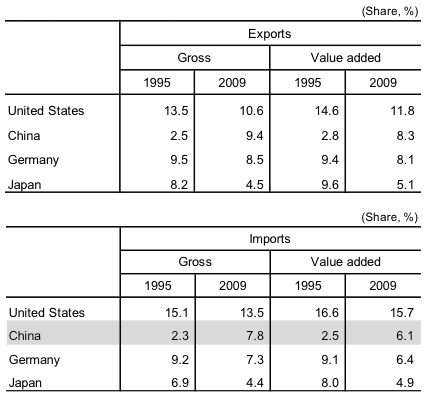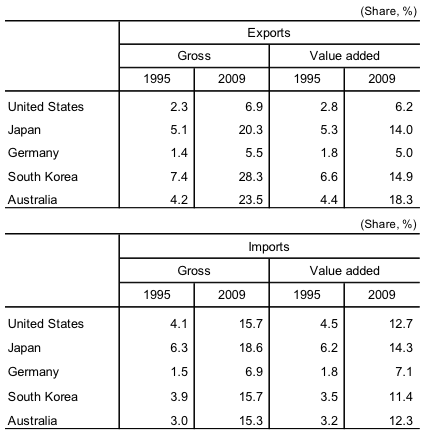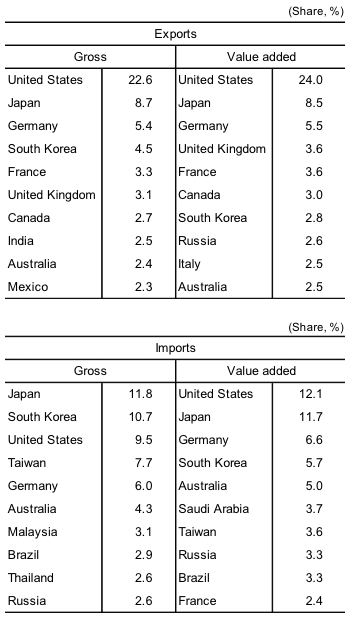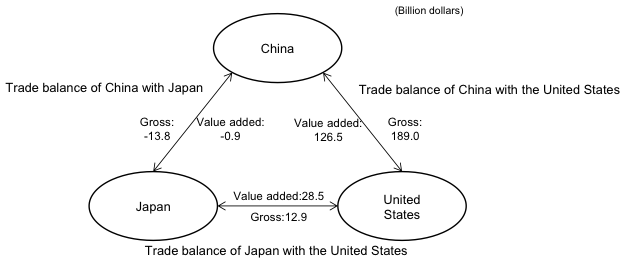Statistics on Trade in Value Added as a new analytical tool
China is becoming increasingly important not only as the workshop of the world, but also as the market for the world. As if to symbolize this, China has become the world's largest exporter and second largest importer after the United States in terms of customs statistics since 2009. However, customs statistics face a problem of multiple counting, in which intermediate goods such as parts are recorded as part of exports or imports whenever they cross national borders, as is the case with finished products. They also do not cover trade in services. Therefore, it is no longer possible to understand properly trade with customs statistics alone, given that services trade is expanding while the international division of labor progresses along value chains at the initiative of multinational companies. This problem is particularly serious for newly industrialized economies such as China, where the share of processing trade is significant.
In response, the Organisation for Economic Co-operation and Development (OECD) and the World Trade Organization (WTO) have jointly worked on the Trade in Value-Added Initiative, seeking to clarify trade relations among states by computing exports in terms of the value added of the country of origin of exported goods and services. Some of their findings have been published in the OECD-WTO Statistics on Trade in Value Added (TiVA) Database, which allows us to look at China's foreign trade from a new perspective.
Domestic and overseas value added included in exports of China
According to the OECD-WTO Statistics on TiVA, the percentage of exported goods and services of China (on a gross basis) accounted for by domestic value added (hereinafter, "domestic value added ratio") in 2009 was 67.4%, with the remaining 32.6% imported from overseas in the form of intermediate goods such as parts.
Although the domestic value added ratio of China is not as high as those of developed nations, it has been rising in recent years. First, in the cross-section comparison, China's domestic value added ratio of 67.4% is significantly lower than those of the United States and Japan (88.7% and 85.2%, respectively). This reflects the fact that China does not produce many high value-added parts domestically and relies on imports (Note). Also, tracking changes in chronological order, the domestic value added ratio of China had fallen from 88.1% in 1995 to 63.6% in 2005, but rose subsequently. Generally, the domestic value added ratio of a country depends heavily on the degree of opening up to the world—the extent to which the country's industries are integrated in the international value chain—and the degree of industry sophistication—the proportion of high value-added parts and intermediate goods that the country's industries can produce on their own without relying on imports. Currently in China, the degree of opening up is increasing, and industry is becoming more sophisticated. While the former serves as a factor to reduce the domestic value added ratio, the latter pushes it higher. Changes in the domestic value added ratio of China in recent years suggest that the pushing-up effect with the progress in the sophistication of industry has been greater than the depressing effect due to the higher degree of opening up since around 2005.
Meanwhile, looking at the source of overseas value added included in Chinese exports in 2009, Japan, the United States, South Korea, and Taiwan all rank highly. With the export of intermediate goods from China to these countries also increasing, China has become closely linked to economies in the Asia-Pacific region through production networks.
Size of exports and imports of China
According to OECD-WTO Statistics on TiVA, Chinese exports in 2009 reached $1.284 trillion on a gross basis (9.4% of total global exports) but were $838.6 billion on a value-added basis (8.3%) (Both are the world's second largest figures, after the United States) (Table 1).
Meanwhile, the scale of China's imports in 2009 was $1.0639 trillion on a gross basis (7.8% of total imports in the world), the world's second largest after the United States with $1.8498 trillion (13.5%). On a value-added basis, however, it was $618.5 billion (6.1%), ranking third after the United States with $1.5906 trillion (15.7%) and Germany with $651.0 billion (6.4%). It appears that the figure on a value-added basis represents the market size of China for foreign companies more accurately than that on a gross basis.
Nevertheless, over time, both Chinese exports and imports have been steadily increasing as a share of total world trade on both gross and value-added bases. With this as the backdrop, China's shares of other countries' exports and imports have been increasing on both bases (Table 2).
—Gross vs. Value Added—

—Gross vs. Value Added—

Exports and imports of China by country
The OECD-WTO Statistics on TiVA show that China's major export destinations in 2009 are ranked in the same order on both gross and value-added bases as follows: 1) United States, 2) Japan, and 3) Germany (Table 3). However, the shares of the United States and Germany, which are regarded as markets for finished products, are larger on a value-added basis than on a gross basis, while the shares of Japan and South Korea, which are closely linked to China through value chains, are lower on a value-added basis than on a gross basis.
Meanwhile, while China's major sources of imports in 2009 on a gross basis are ranked in the order of: 1) Japan, 2) South Korea, 3) United States, and 4) Taiwan, the order changes significantly on a value-added basis to: 1) United States, 2) Japan, 3) Germany, and 4) South Korea. This is because imports from the United States and Germany, which are ranked higher on a value-added basis, are centered on finished goods, while those from Japan, South Korea, and Taiwan, which are ranked lower, include a number of intermediate goods that are re-exported from China.
—Gross vs. Value Added—

Asia-Pacific Triangular Trade centering on China, the United States, and Japan
Against the backdrop of expanding Asia-Pacific Triangular Trade, in which China imports intermediate goods such as parts mainly from Asian countries such as Japan and exports finished products to the United States after processing the intermediate goods, China has a trade deficit with Japan and a large surplus with the United States. According to the OECD-WTO Statistics on TiVA, the trade deficit of China with Japan was $13.8 billion in 2009 on a gross basis while the trade surplus with the United States stood at $189.0 billion. On a value-added basis, however, the trade deficit of China with Japan and the trade surplus with the United States have narrowed to $0.9 billion and $126.5 billion, respectively, as imports from Japan and exports to the United States, both of which are overvalued on a gross basis, are corrected (Figure 1).
—Gross vs. Value Added—

Although the largest and the second largest export markets for Japan in 2009 on a gross basis were China and the United States, respectively, the order was reversed on a value added basis because exports to the United States through China (and other Asian countries) are also included in exports of Japan to the United States. Reflecting this, the trade surplus of Japan with the United States is larger on a value added basis than on a gross basis.
Future prospects
The low domestic value added ratio and the large difference between trade statistics on a gross basis and those on a value-added basis are not limited to China; they are a phenomenon common to newly industrialized countries such as South Korea, Taiwan, and Malaysia. In China, however, the international competitiveness of labor-intensive industries has been declining as a consequence of the labor shortage. To address this problem, Chinese companies are shifting their resources toward the production of higher value-added products, and the country' industrial structure is becoming more sophisticated, as symbolized by the rapid development of the automobile industry. Going forward, the domestic value added ratio will move closer to the level seen in advanced nations, as certain parts that hitherto have had to be imported will be replaced by domestic goods. As a result, the gap between trade on a value-added basis and that on a gross basis is expected to narrow as the former will grow faster than the latter.
The original text in Japanese was posted on January 8, 2014.


